Technical science: the importance of interoperability to blockchain
Foreword: With the launch of Cosmos and its potential threat to the Ethereum ecosystem, recent blockchain interoperability has also caused much discussion. This article will delve into the technical details of Cosmos and Polkadot, as well as some of the necessary knowledge to help you understand these protocols at a technical level (using pictures to deepen your understanding). The original author, Kerman Kohli, is translated by the first class.
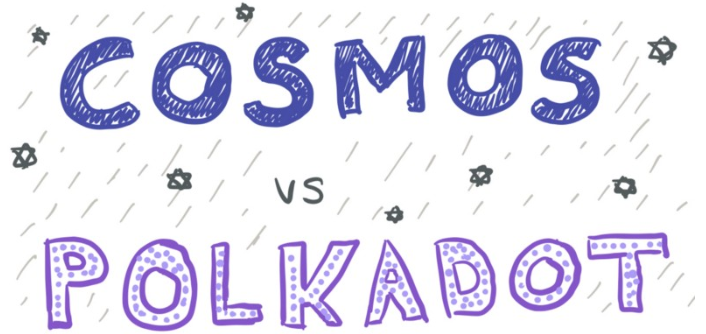
3. A dedicated chain that can be used by other blockchains.
- Where is the hot money in the encryption market flocking?
- Babbitt column | Let technology return to technology, financial return to finance
- Encrypted World and Game of Thrones
Before we dive into the details of a particular interoperability approach, I want to give an overview of the basics of a distributed system to help you understand the concepts below. First of all, we must realize that the blockchain is just a group of machines scattered around the world. If you want to reach a consensus on data, you need to look at distributed systems.
Distributed Systems
As the name suggests, a distributed system is a group of computers that work together to accomplish a specific goal, and the goal is likely to provide the same information to people around the world (such as keeping your Twitter news feed updated). In order to achieve this goal, they must overcome the following problems:
- on time. Each computer/system performs the same tasks at its own pace and time.
- Sort. Trying to clarify the events and times that occur is still very difficult, and the aging is continually evolving, making sorting a complex challenge because each system has its own events and timelines.
- failure. Failure to properly send/receive messages to other systems, or to commit malicious acts (byzantine), or due to a system crash, may result in coordination failures between systems.
As with humans, the solution to most problems is good communication, but for computers, this is a bit complicated because they can communicate asynchronously or synchronously.
How should this be understood?
· Synchronization: Each system has a certain amount of time allocated to communicate in turn, analogous to human communication.
· Asynchronous: Each system can communicate at any time, and the communication content is not preset, just like the Slack we use.
In any case, the blockchain ultimately has to achieve security (a protocol on the same output) and vitality (the chain is growing and operating). If your blockchain is safe but not active, it will stop generating blocks; if it is active but not safe, it will produce a lot of forks unless there are established rules (for example, the longest chain in Bitcoin is the main chain) ), otherwise it is difficult to distinguish the main chain and the fork.
Introducing Practical Byzantine Fault Tolerance (Practical Byzantine Fault Tolerance)
The practical Byzantine fault-tolerant algorithm was developed by Barbara Liskov and Miguel Castro and introduced in 1999. Blockchains such as Cosmos and Polkadot that use the PoS mechanism are designed to incorporate inspiration from PBFT, so it is necessary to do so. Outline and explain how they work.
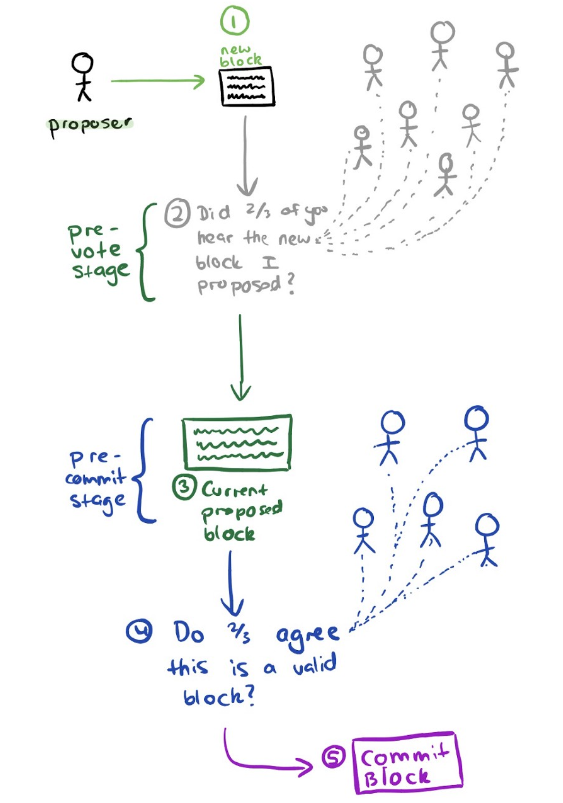
- One party receives a large number of transactions until the number is enough to package a block, and we make such a role a "proposer" because they produce a block.
- Once the block is produced, everyone participates in the pre-vote and confirms that the same block was received. It is worth noting that the block for the incorrect/malicious use is still valid during the pre-voting phase because At this stage everyone just agrees to receive the same block/data.
- Once more than 2/3 of the participants have indicated that they have received the same block, they will enter the pre-commit phase to determine if this is a valid block and there is no malicious behavior.
- If more than 2/3 of the participants voted that the block is valid and correct, then the block can be successfully submitted to the blockchain.
- Increase the height of the blockchain and repeat steps 1-5.
As you can see from the above, the next steps ensure that the block order is known (once the commit, the height of the blockchain increases), each computer can take the time to draw its own conclusions and then convey the results (time) and Faults can be handled (malicious nodes submit blocks that have not been voted).
Interoperability classic case – Cosmos
Cosmos was founded in 2016 by Jae Kwon and Ethan Buchman and has raised more than $17 million for ATOM in ICO. The blockchain is called Cosmos Hub and is connected to other partitions (blockchains), thus allowing communication between different zones. Any blockchain that uses the PoW mechanism (such as Bitcoin, Ethereum, ZCash, or application-specific blockchain) must be connected to the bridge zone through the Inter Blockchain Communication framework.
In terms of structural details, Cosmos Hub uses the Tendermint consensus algorithm (inspired by the practical Byzantine fault-tolerant algorithm), created by Jae Kwon in 2014. This means that before entering the next stage, everyone in the voting phase (pre-voting and pre-submission) is assigned a fixed time to vote. Once the block is completed, the process is irreversible, ie as long as the transaction is in the final state, Real-time mobile & IoT payments. Since there is no need for confirmation, it is called "fast finality".
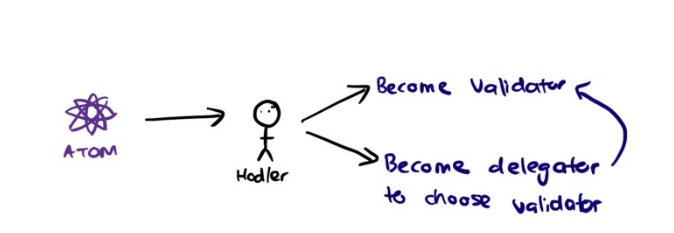
The user can hold ATOM as a verifier or entrust the token to the verifier. The Cosmos blockchain will initially set up 100 verifiers, and plans to increase the number of verifications in the future with reference to the governance parameters. Only those who contribute to the network can participate in the maintenance. cyber security.
Demonstration of demonstration operation: converting ETH to BTC
In order to present these concepts more vividly, I will outline a series of steps to convert ETH to BTC – this example is probably of interest to everyone.
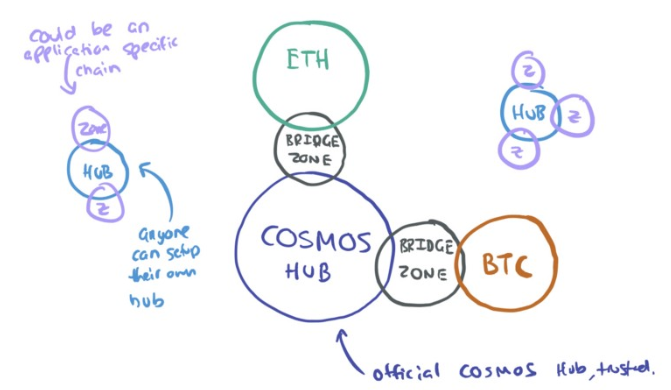
- First, an intermediate trusted zone was created for Ethereum, and a set of verifiers was responsible for relaying the Ethereum Bridge and Cosmos Hub.
- Due to the uncertainty of Ethereum and Bitcoin (the current chain may not be the main chain), the verifier needs to wait for a certain amount of confirmation to complete before the transaction is considered reliable.
- Once the verifier determines that the transaction is in the final state, it can initiate a transaction from the region to Cosmos Hub, indicating that they did receive the Ethereum, and then the Hub will create a Wrapped Cosmos ETH format, and all remaining Cosmos partitions will also be known. .
- Assuming the exchange rate has been determined in advance, the Wrapped Cosmos ETH will be replaced by the Wrapped Cosmos BTC, which will be sent to the Bitcoin intermediate trusted zone and then sent to the specified address on the Bitcoin chain.
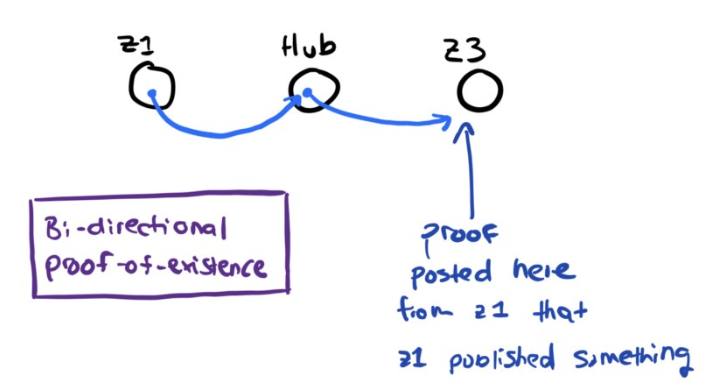
Some assumptions/parts in this model require attention:
- Cosmos Hub needed to ensure that the Wrapped Cosmos asset balance was correctly incremented/decremented. Although this was a potential drawback, the system designed by the Cosmos team allowed anyone to create a hub in their own way. Essentially, the Cosmos network consists of hubs and partitions operated by different groups.
- You need to ensure that each partition is trusted, correctly deliver the asset to send/receive messages, and also implement the sender's trust in the verifier—the verifier will correctly communicate the message without stealing the asset.
Interoperability classic case – Polkadot
Polkadot was founded by Gavin Wood, co-founder and former chief technology officer of Ethereum, and president of the Web3 Foundation. Polkadot launched the token DOT at the end of 2017, raising more than $145 million. If Cosmos is an open network of hubs and partitions, then Polkadot is a single "replay chain" that brings many benefits to "parachains" (parallelizable chains).
Several key aspects of Polkadot's innovation are as follows:
- The security of each parallel chain comes from the verifier on the trunk chain. Once connected to the Polkadot network as a parallel chain, it can simultaneously gain the same level of security as the Polkadot network. In Cosmos, each new chain needs The verifier, the security performance is dominated by itself.
- Parallel chains can interact with other parallel chains using trust-free interchain communication. Users who want to communicate across links do not need to trust every chain they interact with, but only need to trust the entire security of the entire Polkadot network. Sex, this works differently than Cosmos – users don't need to rely on independent verifiers to trust the source chain, the relay chain and the target chain.
Polkadot's consensus mechanism consists of two parts: GRANDPA and BABE. GRANDPA is a terminating tool that draws on some of the ideas of the GHOST fork selection rule (such as Ethereum's Casper), while BABE is a kind of Oruroboros block generation mechanism similar to Cardano. The introduction of the former allows a part of the chain to "finalize" It cannot be restored, separating the finalization tool from the generated block, allowing the less efficient finalizer to take effect in different processes of generating the block, which means that the block generation can be scaled, which is different from the PBFT-based Cosmos Tendermint algorithm. .
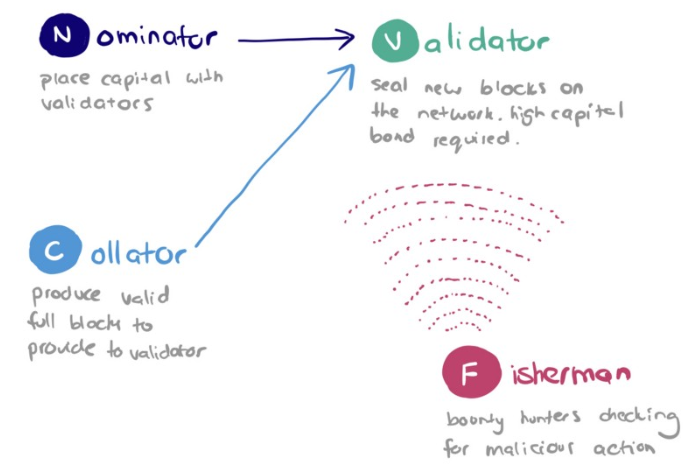
The Polkadot ecosystem contains the following roles:
· Collators – Generate blocks for parallel chains and deliver information to verifier validation.
· Nominator – allocate funds to the verifier to participate in the equity mechanism.
· Validator – a new block that needs to meet high bond requirements and is actually responsible for packaging the relay chain. The key functions include: signing a new block; participating in GRANDPA to improve the relay chain; by confirming whether the transaction is correct or cross- Whether the chain message has been processed to verify the parallel chain block.
· Fishermen—review network nodes as “bounty hunters” to discover malicious behavior.
One way to look at Polkadot correctly is to think of it as an interconnected system, connecting the various chains that want to communicate via bridges, and all the parallel chains and relay chains work together as a whole. Parallel chains can contain custom logic that handles their own state transitions while communicating and passing messages with other chains. Parallel chains are free to communicate with other chains, and in the Cosmos network, all communication must rely on the hub.
Thanks to the central design concept, Polkadot's structure is elegant – parallel chains passively read information from bridge-contracts without relying on connection contracts to send messages in parallel chains. Each parallel chain has the same status, that is to say, Polkadot's cross-chain network is truly “de-trusted”, and the vested interests of the parallel chain are consistent with the relay chain, regardless of any parallel chains verified, in addition, every other segment Time, the verifier will also be redistributed across the chains.
Demonstration of figurative operation: How to operate the token conversion between Bitcoin and Ethereum chain?
To give a more precise example, what if you want to implement token conversion between parallel chains? Take the conversion of the closely watched ETH and BTC as an example:
Collectors on the Ethereum parallel chain will pass the block header information to the verifier on the parallel chain, and the verifier will sign and publish the relevant transaction in the Ethereum Connect Smart Contract in a parallel chain identifiable, communicable format. Any ETH sent will be held by the Polkadot certifier, and the verifier will also provide DOT as collateral for the invalid transaction. Subsequently, the Ethereum parallel chain and the Bitcoin parallel chain will create the communication. After verification, the latter will BTC. Send to the specified address. Specific design decisions have not yet been made, but in the center of cross-chain communication is always "to trust."
One thing to note is that Polkadot allocates parallel chain slots by trusting auctions on the chain. These auctions involve a period of DOT locking, keeping the parallel chain connected to the Polkadot network. Governance will intervene and address the problem in the event of a serious breach in the parallel chain or an emergency in which a suspected involvement in malicious acts occurs. Polkadot follows the chain governance mechanism, which is what it considers to be the best way to manage cryptocurrency networks.
As Gavin Wood puts it: “There is no introduction of chain governance, including blockchains that lead to upgrades through various mechanisms will eventually be poisoned by 'populism'. I don’t think of 'chain processing', 'chain signal' and The 'rough consensus' can provide an effective means for stakeholders in the blockchain ecosystem to effectively manage and promote the long-term prosperity of the blockchain, and I don't think governance reform will work."
timeline
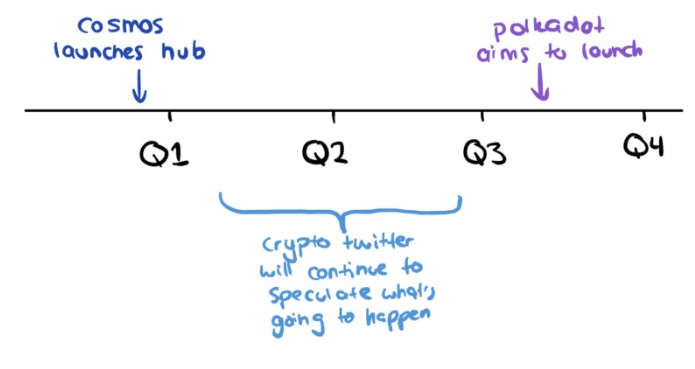
Many of the core issues of interoperability seem to have high-level solutions, but execution is far from enough. Cosmos was launched in March 2019, but only Cosmos Hub was released and run. Their next job is to determine how the inter-chain communication framework works. Polkadot will be launched at the end of 2019, and only the relay chain is currently online.
In general, I am excited about the launch of Cosmos and Polkadot. I am curious about how to promote the adoption of developers; how to balance each parallel chain; and how to play parallel chains. Creating an application-specific chain is still an empty talk because the infrastructure is far from perfect and developers need to consider the resources and manpower needed to achieve adequate security.
Will the future compromise on the vision? Hard to say. Perhaps the offline management of Ethereum brings an opportunity for their development, although the roadmap is slow due to the need to achieve a high level of security without trust.
On the other hand, all cryptocurrency networks gradually delegate security to other chains, such as Ethereum, and once the existing community is fully secure, the chain can focus on developing its own chain. MakerDAO is a good example. They have enough resources to create their own chains and get enough support by becoming part of the Polkadot parallel chain. If sufficient support is not guaranteed, it can create a bridge area on Cosmos. Security management. Polkadot plans to provide bridge-slots for chains that cannot guarantee security but can communicate.
These are the glimpses we should make as a community, not the blockchain as a zero-sum game. I am excited about everything that the blockchain brings, and I hope to hear from you, please contact me on Twitter @kermankohli.
This article Source: First Class Warehouse https://first.vip/shareNews?id=1459&uid=50386
Original Source: https://tokeneconomy.co/the-state-of-crypto-interoperability-explained-in-pictures-654cfe4cc167
For reprint, please indicate the source!
We will continue to update Blocking; if you have any questions or suggestions, please contact us!
Was this article helpful?
93 out of 132 found this helpful
Related articles
- Market Analysis: BTC bulls are strong, but may be strong
- April 21 market analysis: Only BTC can drive the market to do more emotions?
- The impact of IEO on the encryption market and the Token model
- Interview with Babbitt | Du Xiaoman Li Feng: "Blockchain + Finance" has a history of shaking
- How long does it take to crack your private key? If the world's bitcoin miners are against you
- Monroe celebrates its 5th birthday, what has this popular privacy coin experienced?
- Troubled by the keyboard man, the founder of the dog coin suspected of withdrawing from the social network






